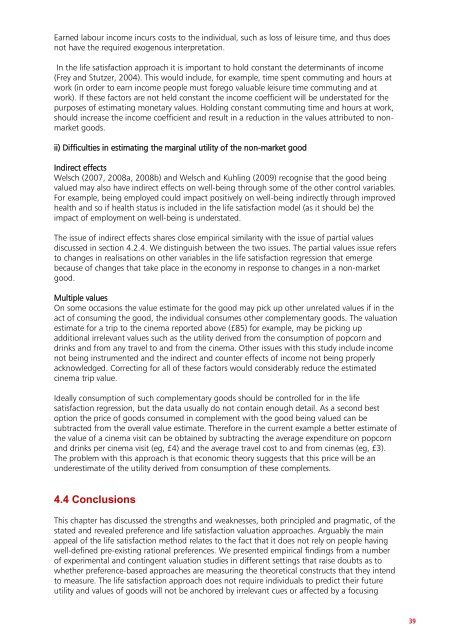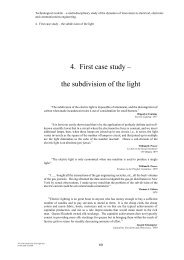Valuation Techniques for Social Cost-Benefit Analysis: - HM Treasury
Valuation Techniques for Social Cost-Benefit Analysis: - HM Treasury
Valuation Techniques for Social Cost-Benefit Analysis: - HM Treasury
You also want an ePaper? Increase the reach of your titles
YUMPU automatically turns print PDFs into web optimized ePapers that Google loves.
Earned labour income incurs costs to the individual, such as loss of leisure time, and thus does<br />
not have the required exogenous interpretation.<br />
In the life satisfaction approach it is important to hold constant the determinants of income<br />
(Frey and Stutzer, 2004). This would include, <strong>for</strong> example, time spent commuting and hours at<br />
work (in order to earn income people must <strong>for</strong>ego valuable leisure time commuting and at<br />
work). If these factors are not held constant the income coefficient will be understated <strong>for</strong> the<br />
purposes of estimating monetary values. Holding constant commuting time and hours at work,<br />
should increase the income coefficient and result in a reduction in the values attributed to nonmarket<br />
goods.<br />
ii) Difficulties in estimating the marginal utility of the non-market good<br />
Indirect effects<br />
Welsch (2007, 2008a, 2008b) and Welsch and Kuhling (2009) recognise that the good being<br />
valued may also have indirect effects on well-being through some of the other control variables.<br />
For example, being employed could impact positively on well-being indirectly through improved<br />
health and so if health status is included in the life satisfaction model (as it should be) the<br />
impact of employment on well-being is understated.<br />
The issue of indirect effects shares close empirical similarity with the issue of partial values<br />
discussed in section 4.2.4. We distinguish between the two issues. The partial values issue refers<br />
to changes in realisations on other variables in the life satisfaction regression that emerge<br />
because of changes that take place in the economy in response to changes in a non-market<br />
good.<br />
Multiple values<br />
On some occasions the value estimate <strong>for</strong> the good may pick up other unrelated values if in the<br />
act of consuming the good, the individual consumes other complementary goods. The valuation<br />
estimate <strong>for</strong> a trip to the cinema reported above (£85) <strong>for</strong> example, may be picking up<br />
additional irrelevant values such as the utility derived from the consumption of popcorn and<br />
drinks and from any travel to and from the cinema. Other issues with this study include income<br />
not being instrumented and the indirect and counter effects of income not being properly<br />
acknowledged. Correcting <strong>for</strong> all of these factors would considerably reduce the estimated<br />
cinema trip value.<br />
Ideally consumption of such complementary goods should be controlled <strong>for</strong> in the life<br />
satisfaction regression, but the data usually do not contain enough detail. As a second best<br />
option the price of goods consumed in complement with the good being valued can be<br />
subtracted from the overall value estimate. There<strong>for</strong>e in the current example a better estimate of<br />
the value of a cinema visit can be obtained by subtracting the average expenditure on popcorn<br />
and drinks per cinema visit (eg, £4) and the average travel cost to and from cinemas (eg, £3).<br />
The problem with this approach is that economic theory suggests that this price will be an<br />
underestimate of the utility derived from consumption of these complements.<br />
4.4 Conclusions<br />
This chapter has discussed the strengths and weaknesses, both principled and pragmatic, of the<br />
stated and revealed preference and life satisfaction valuation approaches. Arguably the main<br />
appeal of the life satisfaction method relates to the fact that it does not rely on people having<br />
well-defined pre-existing rational preferences. We presented empirical findings from a number<br />
of experimental and contingent valuation studies in different settings that raise doubts as to<br />
whether preference-based approaches are measuring the theoretical constructs that they intend<br />
to measure. The life satisfaction approach does not require individuals to predict their future<br />
utility and values of goods will not be anchored by irrelevant cues or affected by a focusing<br />
39





![AIRTO [Professor Dr Brian Blunden] - HM Treasury](https://img.yumpu.com/15492848/1/184x260/airto-professor-dr-brian-blunden-hm-treasury.jpg?quality=85)










